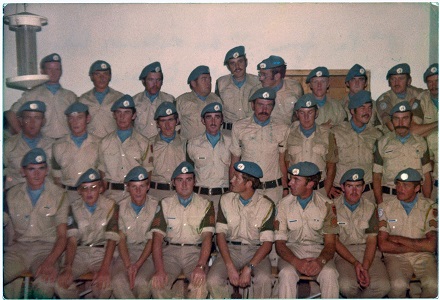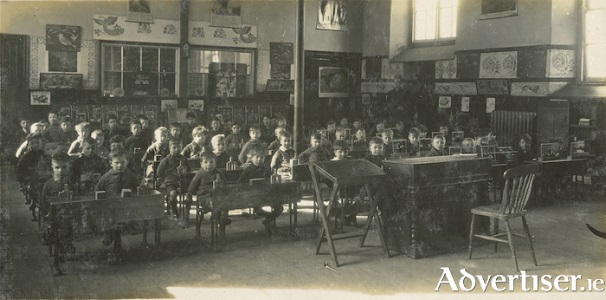Old Galway
The Crane Bar

by Tom Kenny
This pub, which is situated on the corner of William Street West and the Small Crane, was originally known as the West End Bar. In the 1930s it was owned by Paddy and Angela (known as Alda) Smith who lived over the pub. They also owned the garage behind the pub, which Paddy managed. This was where Bell, Book and Candle bookshop is today. Mrs Smith was from Loughrea and when she and her husband retired, they sold the business to her brother Mickey Coen. He ran it until 1970 when Padraig Cummins took it over. Padraig had a business in Menlo making concrete slabs.
CALLING ALL GRADUATES OF ST. PATRICKS NATIONAL SCHOOL

by Tom Kenny
On April 1st, 1954, 941 boys marched from the Bish National School, Nun’s Island and from the Old Mon in Market St. to their ultra-modern bright new school St. Patrick’s, which was situated at the corner of Lombard St. and Bridge St. The new school was built on a site which had been the location of the Shambles Barracks which was occupied by the British Army for many years up until 1909. It was then bought by Fr. Dooley, the parish priest of St. Patrick’s for £1,200. It functioned as a tenement for a number of years and eventually became derelict. For a while some locals used to play a form of pitch and putt in the grounds. Bishop Michael Browne considered the site as a location for his proposed cathedral. Construction work on the new school commenced in 1952 and on March 31st, 1954, the Minister for Education, Seán Moylan officially opened it. The following day, the pupils arrived.
THE JES LEAVING CERT CLASS OF 1968

by Tom Kenny
It is interesting to meet someone again after a long period of time, especially someone with whom you spent five days a week for about six years, but that is what school reunions are all about. People will have inevitably aged and may have gained bellies, more wrinkles, their hair greyer than before or maybe have no hair at all, so there is often a little tension mixed with the expectation of meeting them again. But the end result is generally delight at reviving old friendships, at the renewed camaraderie, at all the nostalgia, the memories of sporting occasions, the sharing of photographs and, of course, the stories about particular teachers. Indeed, some who were slogged or mistreated by teachers may use the reunion as a kind of revenge. Inevitably, some stories will have taken on legs --- “The older we got, the better we were”. The reunion is also an occasion to remember colleagues who have died in the interim.
Platoon

by Tom Kenny
1958 was the first time the Irish Army sent a number of personnel on a peace mission to work abroad. They were a team of observers who went to the Lebanon. The next group to go abroad were members of An Chéad Cath and they were stationed in the Congo from 1960-1963. From 1963-1974, our soldiers were stationed in Cyprus, and later a number were sent to the Sinai Desert for 9 months. After the Dublin/Monaghan bombings, all Irish military personnel were withdrawn and brought home.
ST. NICHOLAS’ COLLEGIATE CHURCH, 1823

by Tom Kenny
This drawing of the Collegiate Church was done in December 1823 (at about 2pm according to the clock) by E.W. Thompson. It was presented to the vestry by another E.W. Thompson of Tullymore, Broughshane, Co. Antrim, in 1947.
The artist was standing in Shop Street, and by leaving out what is Eason’s Corner today, he gave himself licence to include more of the church grounds than he could see at any one time from that angle. The corner of the wall facing us is that of Church Lane and Shop Street. The Tholsel, or Town Hall was situated on this corner. It had recently burnt down and some of the stone was removed to build the facade of the Bank of Ireland at the top of Eyre Square. You can still see the old Tholsel arches there. The rest of the stone was probably used in building the wall we see, thus helping to widen the street. There are railings now where you can see the gate at the church end of the wall.
THE GARDA BARRACKS, SALTHILL

by Tom Kenny
The building which houses the Garda Barracks in Salthill was originally called Forster Park and was constructed as a summer house by the Blake Forster family at the end of the eighteenth century. In 1850, it was bought by the Palmer family who were well known whiskey distillers, flour millers and makers of porter. Most of their business was based in Nun’s Island. Their coat of arms can still be seen on the facade of this building. We can presume that Palmer’s Rock (sometimes known as Saunder’s Rock) on the shore in front of this house, was named after a member of the family.
The dredging of the river

by Tom Kenny
The main channel discharging all the water from loughs Corrib and Mask is the Galway River, flowing from Lough Corrib through the city to the sea. Among the structures built in 1850 and the following years, during the course of a drainage scheme carried out by what was then known as The Board of Public Works in Ireland, was the main regulating weir across the Corrib at Waterside. Its function was to control the river level at Galway in the interests of draining, milling, and navigation. It was built at a point in the river where the water descended though rapids.
The Monastery School

by Tom Kenny
Walsh on a site belonging to the Charity Free School which was formerly an army barracks, and it opened in January 1827. Three hundred boys attended on that day. The total funding available to the school was the sum of one shilling.
Within a year, there were 700 pupils attending. Most of those boys came from a very poor background, and the Brothers found it difficult to create an enthusiasm for learning among lads who were half starved and often half clothed. A fundraising campaign was launched and, within a few years, sufficient finance had been raised to open the Poor Boy’s Breakfast Institute. This enabled every child attending the school to have a breakfast every morning before classes began. The breakfasts were served every day for many years, and during the Famine they were serving about a thousand people daily. Tradition has it that there were times when the Brothers themselves were occasionally on the verge of collapse as they were sharing their own food with the boys.
.png)